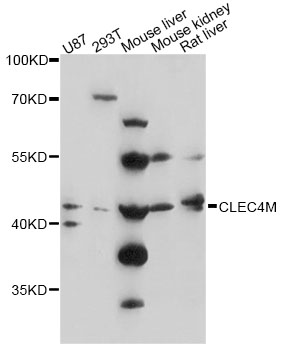-
Product Name
CLEC4M Polyclonal Antibody
- Documents
-
Description
Polyclonal antibody to CLEC4M
-
Tested applications
WB
-
Species reactivity
Human, Mouse, Rat
-
Alternative names
CLEC4M antibody; CD209L antibody; CD299 antibody; DC-SIGN2 antibody; DC-SIGNR antibody; DCSIGNR antibody; HP10347 antibody; L-SIGN antibody; LSIGN antibody; C-type lectin domain family 4 member M antibody
-
Isotype
Rabbit IgG
-
Preparation
Antigen: Recombinant fusion protein containing a sequence corresponding to amino acids 280-399 of human CLEC4M (NP_055072.3).
-
Clonality
Polyclonal
-
Formulation
PBS with 0.02% sodium azide, 50% glycerol, pH7.3.
-
Storage instructions
Store at -20℃. Avoid freeze / thaw cycles.
-
Applications
WB 1:500 - 1:2000
-
Validations

Western blot - CLEC4M Polyclonal Antibody
Western blot analysis of extracts of various cell lines, using CLEC4M antibody at 1:3000 dilution.Secondary antibody: HRP Goat Anti-Rabbit IgG (H+L) at 1:10000 dilution.Lysates/proteins: 25ug per lane.Blocking buffer: 3% nonfat dry milk in TBST.Detection: ECL Basic Kit .Exposure time: 90s.
-
Background
Probable pathogen-recognition receptor involved in peripheral immune surveillance in liver. May mediate the endocytosis of pathogens which are subsequently degraded in lysosomal compartments. Is a receptor for ICAM3, probably by binding to mannose-like carbohydrates.; (Microbial infection) Acts as an attachment receptor for Ebolavirus.; (Microbial infection) Acts as an attachment receptor for Hepatitis C virus.; (Microbial infection) Acts as an attachment receptor for HIV-1.; (Microbial infection) Acts as an attachment receptor for Human coronavirus 229E.; (Microbial infection) Acts as an attachment receptor for Human cytomegalovirus/HHV-5.; (Microbial infection) Acts as an attachment receptor for Influenzavirus.; (Microbial infection) Acts as an attachment receptor for SARS coronavirus.; (Microbial infection) Acts as an attachment receptor for West-nile virus.; (Microbial infection) Acts as an attachment receptor for Japanese encephalitis virus.; (Microbial infection) Acts as an attachment receptor for Marburg virus glycoprotein.; (Microbial infection) Recognition of M.bovis by dendritic cells may occur partially via this molecule.
Related Products / Services
Please note: All products are "FOR RESEARCH USE ONLY AND ARE NOT INTENDED FOR DIAGNOSTIC OR THERAPEUTIC USE"
